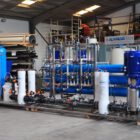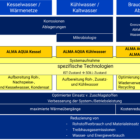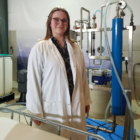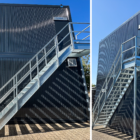Coalescence refers to the physical process in which smaller droplets of liquid or gas bubbles flow together in a continuous phase and form larger units. This occurs when the interfaces between the droplets are destabilized by external influences such as flow, pressure or temperature.
Technical background
Interfacial tension and wetting behavior
Coalescence is significantly influenced by the interfacial tension between the phases. A low interfacial tension makes it easier for the droplets to flow together. The wetting behavior of the continuous phase also plays a decisive role. For example, hydrophobic surfaces promote the coalescence of oil droplets in water.Mechanisms of coalescence
- Collision and contact: Droplets approach each other due to turbulent flow or gravity.
- Film outflow: A thin liquid film forms between the droplets, which is broken down by van der Waals forces or shear flows.
- Fusion: As soon as the film is broken down, the droplets merge to form a larger unit.
Coalescence technologies in practice
Coalescence separators
Coalescence separators are used to efficiently separate oil-water emulsions or air-water mixtures. They typically consist of special media such as lamellar inserts or fibers that promote the contact and fusion of the droplets.- Example: Oil-water separation in the petrochemical industry.
Filtration coalescence
This is a combination of filtration and coalescence in which solids and liquid droplets are removed simultaneously.- Application: Removal of fine emulsions in the chemical industry.
Membrane coalescence
Porous membranes can be used to induce droplet coalescence. As soon as the droplets reach a certain size, they roll off and are separated.- Area of application: Gas removal in water treatment plants.
Challenges and optimization
Temperature and pressure influences
The efficiency of coalescence is heavily dependent on operating conditions such as temperature and pressure. Higher temperatures can influence the viscosity and therefore the separation efficiency.Chemical stabilization of emulsions
Certain surfactants and additives stabilize emulsions and prevent coalescence. These substances must either be removed or neutralized to promote coalescence.Optimized design of coalescence separators
The geometry and the coalescence medium used must be adapted to the specific requirements of the wastewater.
Conclusion
Coalescence is an important process in industrial water and wastewater treatment. It enables the efficient separation of liquids and gases and contributes significantly to the reduction of pollutants. ALMAWATECH offers customized solutions, including innovative coalescence separators that meet the specific requirements of different industries. With advanced technology and many years of experience, we support our customers in optimizing their processes and complying with strict environmental regulations.
For further information on our products, please feel free to contact us at any time!








